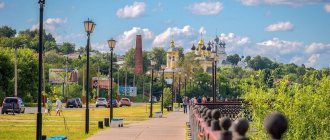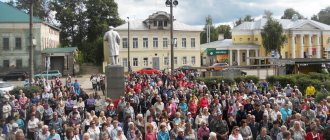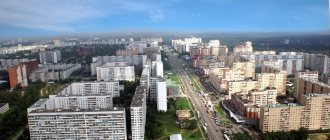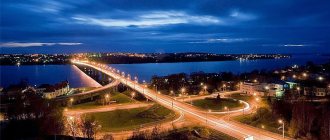Gryazovets
| First mention: | 1538 |
| Population: | 15.5 thousand people |
| Residents: | Gryazovites |
| Timezone: | UTC+3 |
| Time: | Moscow |
| Telephone code: | +7 81755 |
| Day of the city: | August 2 |
It was first mentioned on June 17, 1538 as Pochinok Gryazovitsky. All forms of the name are from the base mud. Chaikina associated the term mud with the synonyms “swamp, swamp” that surrounded the city from the north-west and south-east; a number of other authors associated the name of the settlement with medicinal mud, like that of the Korniliev-Komelsky monastery located near the city. Later it is known as the trading village of Gryazlevitsy (aka Gryazlivitsy, Gryazovitsa, Gryazovits, Gryaznitsa, Gryaztsy.
The impetus for more intensive development of the Gryazovets repair received in the middle of the 16th century. with the opening of trade between Russia and the West through the Arkhangelsk seaport. Finding itself right at its fork, the settlement quickly began to deteriorate. Carts passed through it, sometimes up to 800 carts a day. They moved to transshipment and shipbuilding bases in Vologda and Shuisk.
The railway, which came to Gryazovets in 1872, gave a great impetus to the economic development of the city and the district. The opportunity arose for wider sales of butter products and by the end of the 19th century the district became the largest butter producer in the province, although in terms of size it occupied the penultimate place in it (1.9% of the province's area). In 1894, there were 107 oil mills operating in the district, 17 thousand pounds of butter (272 tons) were exported per year, and in 1911 already over 74 thousand pounds (1184 tons), an increase of 4.5 times. The county was famous for lace-making and flax growing; in Gryazovets itself the fabric dyeing industry flourished, which was reflected in the design of the city coat of arms. Three fairs were held annually in Gryazovets, the main one, Vvedenskaya, brought together merchants from neighboring provinces. Yarn, canvas, and oil were put up for auction.
In the city there is a Center for Culture and Leisure, a museum, several libraries, the Central District Library and its three branches, and the Kolos cinema (since the beginning of the 21st century, a branch of the Center for Culture and Leisure). The main architectural sights of Gryazovets are located in the center along K. Marx and Lenin streets. On Lenin Street, the 19th century mansion of P.I. Gudkov, in which Alexander I stayed, as well as the buildings of the shopping malls, stand out. At the intersection of Lenin and Karl Marx streets there is a mansion of the merchant Razumovsky-Mashaldin, built in the second half of the 19th century, which now houses a local history museum. On the square there is a monument to participants of the Great Patriotic War, a memorial sign to the first mention of the city and a cross in memory of the destroyed Nativity Cathedral. The cemetery contains the Church of the Exaltation of the Cross (early 19th century) and the Church of Cornelius of Komel (1997-2003). The city is also interesting for tourists because it can be called, where several monasteries are located: Korniliyevo-Komelsky, Pavlo-Obnorsky, Arsenievo-Komelsky. Gryazovets is one of many small towns with an old historical center, built up mainly with stone mansions of the late 19th and early 20th centuries. In the center and on the outskirts there are small wooden houses with carved platbands. Several 19th-century “insurance” signs on city houses remained until the end of the 20th century.
Story
The first mention of Gryazovets dates back to 1538, when it was described as a settlement dependent on the Kornilyevo-Komelsky monastery.[3] The settlement was registered on January 25, 1780, when it became the seat of the Gryazovets district of the Vologda governorate.[3] In 1796, the governorship was abolished, and its part, which included the Gryazovets district, became the Vologda province.[11][12]
During the 19th century, the population of Gryazovets ranged from two to three thousand people, most of whom were employed in agriculture.[13] The most common industry was dyeing.[13] In 1872, a railway connecting Yaroslavl and Vologda was built, and a railway station was opened in Gryazovets, which contributed to the development of trade.[13]
On August 7, 1924, the Gryazovets district was abolished, and the territory became part of the Vologda district.[14] On July 15, 1929, several provinces, including Vologda, were united into the Northern Region, districts were abolished, and Gryazovets became the administrative center of the newly formed Gryazovets district.[14]
The capital Vologda is the second largest populated area
The capital of the region, Vologda, compared to the leader of the rating, is smaller in area and number of inhabitants with indicators of 116 km²/312,420 Vologda residents. However, in terms of density it is ahead of Cherepovets: the figure is impressive, amounting to 3,433.19. For comparison, in neighboring St. Petersburg the density is 3,837.47, in Arkhangelsk located to the north - 1,187.9.
Tourist attractiveness, high density, and relatively high standard of living lead to excessive motorization, traffic jams, and environmental deterioration. The level of air pollution is high: the main source of problems is exhaust gases. Industrial enterprises make a smaller negative contribution, but do not strive to modernize environmental safety systems.
The maximum period of growth of Vologda residents occurred in Soviet times, when the settlement grew from 60,000 to 280,000. After the collapse of the USSR, a demographic decline began, the traces of which can still be felt today: it is impossible to talk about stable growth, the increase occurs spasmodically.
Administrative and municipal status
Within the structure of administrative units, Gryazovets serves as the administrative center of Gryazovets District.[1] As an administrative division, it is part of the Gryazovets district as a city of regional significance of Gryazovets
.[2]
As a municipal entity, the city of district significance of Gryazovets, together with the village of Pirogovo in the Pertsevsky village council and the village of Svistunovo in the Rostilovsky village council of the Gryazovets district, is included in the Gryazovets municipal district as the Gryazovets settlement.
.[6]
The most significant cities of the Vologda region by population
There are 15 cities in the Vologda region, among which there is not a single million-plus city. The largest settlements are the capital Vologda and industrial Cherepovets. Interesting: the latter is home to 6,436 more people than are registered in the capital. Next by a wide margin are Sokol and Ustyug, where the number of citizens is almost 10 times less than the largest settlements in the region. Sokol is included in the list of single-industry towns and is a woodworking center. The birthplace of the Slavic Santa, along with ancient Vologda, is attractive from a tourist point of view.
The Vologda region boasts the presence of 8 urban-type settlements. An interesting fact: in two of them - Sheksna and Kaduya, the number of residents even exceeds that of most cities in the region, amounting to 18,872 and 11,280, respectively. The list of the most populous includes:
- Cherepovets - 318,856.
- Vologda - 312 420.
- Sokol - 37,192.
- Veliky Ustyug - 31,606.
- Gryazovets - 14,916.
- Babaevo - 11,493.
- Vytegra - 10,232.
- Totma - 9,895.
- Kharovsk - 9,185.
- Belozersk - 8,914.
Due to such a large population gap between the two leading and small settlements, the social portrait of the region is extremely ambiguous. On the one hand, the indicators of poverty and unemployment are lower than the Russian average. In fact, the statements described above are typical only for Cherepovets, Vologda and their suburbs. On the periphery, in small villages and towns, the situation is the opposite: lack of work, social degradation.
Cherepovets is the largest in the Vologda region
Cherepovets is the largest city in the Vologda region, where, according to information at the beginning of 2022, 318,856 people live. The area is small - 121 km², but for such a modest number of residents it is quite enough. The population density is 2,632.52 people/km. This value is typical for many small regional capitals. For comparison, in the capitals of neighboring entities it is:
- Yaroslavl - 2,957.83;
- Kostroma - 1,918.89;
- Petrozavodsk - 2,068.07.
It is an important industrial center, home to Russia's most famous mining and steel industries. Along with JSC Apatit, which operates in the chemical industry segment, it is one of the most significant enterprises: together the companies provide jobs for 40% of Cherepovets residents. In total, there are more than 1,500 enterprises, making the locality one of the ten largest industrial centers in the country. The level of industrial output per number of citizens is almost twice the national level. Thanks to the stable economy, the number of inhabitants does not stop growing: since 2008 it has increased by 10,000.
Economy
Industry
Timber and food industry enterprises are located in Gryazovets.
Transport
One of the main highways of Russia, which connects Moscow and Arkhangelsk, passes near Gryazovets. There are also local roads, bus traffic comes from Gryazovets.
There is a railway station in Gryazovets on the connecting railway. Yaroslavl and Vologda.
Gryazovets has a gas pumping station. Here the Gryazovets – Vyborg Gas Pipeline branches off from the main Northern Lights Pipeline in a westerly direction.[13]
Recommendations
Notes
- ^ a b c d f
Permit No. 178 - ^ a b c
Law No. 371-OZ - ^ a b c d
N. V. Soldatova (2006). G. V. Sudakov (ed.). Vologda Encyclopedia (PDF) (in Russian). Vologda: VSPU, Rus. p. 192. ISBN 5-87822-305-8. Received November twenty-first, 2013. - ^ a b
Federal State Statistics Service of Russia (2011).
“All-Russian Population Census 2010. Volume 1" [All-Russian Population Census 2010, vol. 1]. All-Russian Population Census 2010 [All-Russian Population Census 2010]
(in Russian). Federal State Statistics Service. - "26. The size of the permanent population of the Russian Federation by municipalities as of January 1, 2022.” Federal State Statistics Service. Retrieved January 23, 2022.
- ^ a b c d f
Law No. 1114-OD - "On the calculation of time." Official Internet portal of legal information
(in Russian). June 3, 2011. Retrieved January 19, 2022. - Post office. Information and computing center of OASU RPO. ( Post office
).
Search for postal facilities ( Search for postal facilities
) (in Russian) - Federal State Statistics Service of Russia (May 21, 2004). > [Population of Russia, its federal districts, federal subjects, districts, urban settlements, rural settlements - administrative centers, rural settlements with a population of more than 3000 people] (XLS). All-Russian Population Census of 2002 [All-Russian Population Census of 2002]
(in Russian). - “All-Union Population Census of 1989. The actual population of the union and autonomous republics, autonomous regions and districts, territories, regions, urban settlements and villages. Administrative-territorial division of the Arkhangelsk province in the 18th-20th centuries.” (in Russian). Archives of Russia. 2000. Archived from the original on July 24, 2011. Retrieved November 25, 2013.
- Public administration in the 18th–19th centuries (in Russian). Government of the Vologda region. Archived from the original on December 3, 2013. Retrieved November 25, 2013.
- ^ a b c d
Stages of historical development (in Russian). Administration of the Gryazovets Municipal District. Archived from the original on October 6, 2013. Retrieved November Twenty-first, 2013. - ^ a b
Information on changes in the administrative-territorial structure and network of party and Komsomol bodies of the Vologda region (1917–1991) (in Russian). Archives of Russia. Received November twenty-first, 2013. - Monuments of history and culture of the peoples of the Russian Federation (in Russian). Ministry of Culture of Russia. Retrieved June 2, 2016.
- Local History Museum of Gryazovets (in Russian). Russian Network of Cultural Heritage. Received November twenty-first, 2013.











